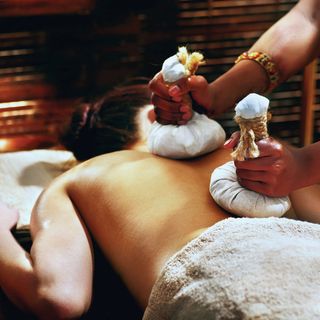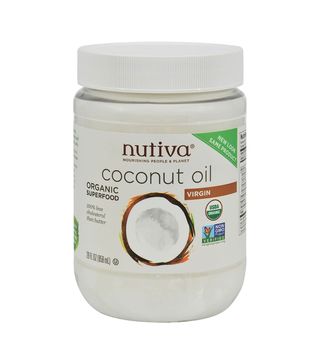I Spent Days Learning About Ayurveda—and TBH, This Massage Was Transformative

Welcome to The Now Age, our tribute to the fascinating and ever-evolving landscape of alternative wellness. From Reiki to plant medicine, we're taking a closer look at how holistic healing can factor into the modern woman's lifestyle—with curiosity and a healthy dose of skepticism.

I was first introduced to Ayurveda through a friend who had recently gone through some health troubles, during which she did a ton of research and realized her diet was largely the culprit. Since then, she's been on a mission to find her own version of wellness through her specific dosha. "You're such a Pitta," she told me, though I had no idea what that meant. A few Google searches later, I was right there with her, my eyes widening with every detail I read. We decided to spend a few days at YO1 Luxury Nature Cure, an Ayurveda-specific resort in the Catskills that offers a ton of treatments, meals, and education based on your dosha.
Let me back it up a bit. A "dosha" is one of three energies believed in Ayurveda to circulate in the body and govern physiological activity. "In Ayurveda, the five elements that are found in all living things—ether, air, fire, water, and earth—are the building blocks of life. While this foundation unites all humans, the manifestation of those elements through the doshas is what gives rise to our differences. How the three doshas appear, and in what proportion, is what makes each of us unique," writes The Chopra Center. There's Vata, an air dosha, "like the wind," one of the naturopathic counselors told me, who gets cold easily, has an energetic and creative mind, and a lean body. Then, there's Pitta, a fire dosha. Pittas have regular digestion, a warm body temperature, and a high sex drive. They also often suffer from redness and irritation, things like rosacea, heartburn, and the like. The third dosha is Kapha, the earth dosha, with characteristics including deep sleep, fluid retention, and thick hair. You can take a quiz online, but the best way to pinpoint your specific dosha is to have a specialist identify it for you. They can do this by listening to your pulse or examining your tongue.
I was diagnosed a Pitta by my counselor (which, after reading more about it, makes so much sense) and was recommended an Abhyangam Ayurvedic massage. The massage is meant to soften any dryness, lubricate your joints, decrease anxiety and depression levels, as well as nourish the entire body. In addition, it assists in the elimination of impurities, calms nerves to promote deeper sleep, and, many report, relieves chronic back pain and enhances vision. This massage is meant to pacify Vata and Pitta doshas and stimulate Kapha.
"Abhyangam therapy is helpful for all tri-dosha body constitutions," explains the naturopathic counselors at YO1 Luxury Nature Cure. "Abhyangam stroke, pressure, and oil varies according to dosha." The masseuse chooses the specific medicinal oils based on your dosha previous to the massage. Since I'm a Pitta, she chose calming, cooling oils to balance the fieriness of my dosha. "For Pitta, a medium stroke and pressure will be used with specific Pitta-balancing oils such as sunflower or coconut oil. As self-massage, this can be done three to four times per week to calm the fiery nature of a Pitta."
I was asked to change into a disposable bra and underwear and sit on a chair. The masseuse started massing my head, neck, and shoulders in the chair, the moved me to the massage table. For the second position, I was massaged face down, the supine position. Next was the left lateral position, where I was on my side with one leg straight and the other at a 90-degree angle. Then the same thing on the other side, to my back, and back on my stomach. "According to Ayurveda, there are seven body tissues—rasa, rakta, mamsa, meda, asti, majja, andsukra," explain YO1's Luxury Nature Cure naturopathic counselors. "Since the warmed and medicated oil is meant to reach the deep-tissue level, Ayurveda sages found that to cross each level of tissue, it requires 300 secs. Based on this calculation, they have created these positions for continuous friction on the body."
Other oils that can be used during this type of massage include ashwagandha oil to increase strength and stamina; mahanarayana oil for joint pains; bhringaraj oil to encourage sound sleep; almond oil and mustard oil to warm; dhanwantaran tailam for arthritis, headaches, and neuro-muscular conditions; as well as pinda tailam to relieve pain and inflammation in your joints.
I left the massage feeling relaxed and a little woozy—like some serious stuff had gone down in my body. I was warned I'd be sleepy (it's helpful for deeper sleep), and it'd speed along my digestion. Since, I've been trying to keep my diet somewhat in line with my dosha (cooling foods that are sweet, bitter, and astringent like cucumbers, melons, and leafy greens), and I've really felt the aftereffects of the massage. I'd been dealing with some lingering back pain, joint stiffness, and lethargy, mostly from sitting at a desk all day, and that has practically vanished since my weekend at YO1. Maybe there is something to this all this Ayurveda stuff after all.
Next up: This is how Ayurvedic breast massages can help promote lymphatic flow.
Disclaimer
This article is provided for informational purposes only and is not intended to be used in the place of advice of your physician or other medical professionals. You should always consult with your doctor or healthcare provider first with any health-related questions.


